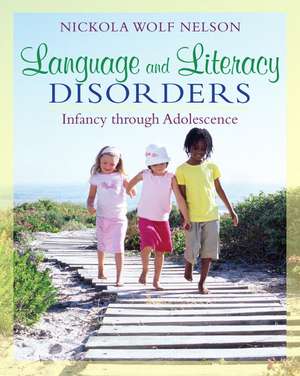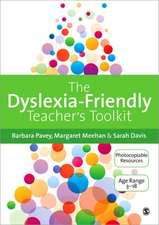Language and Literacy Disorders: Infancy Through Adolescence
Autor Nickola Wolf Nelsonen Limba Engleză Paperback – 31 mar 2009
Preț: 1218.84 lei
Preț vechi: 1433.93 lei
-15% Nou
Puncte Express: 1828
Preț estimativ în valută:
233.30€ • 253.50$ • 196.10£
233.30€ • 253.50$ • 196.10£
Carte disponibilă
Livrare economică 31 martie-14 aprilie
Livrare express 14-20 martie pentru 52.27 lei
Preluare comenzi: 021 569.72.76
Specificații
ISBN-13: 9780205501786
ISBN-10: 0205501788
Pagini: 582
Dimensiuni: 201 x 249 x 33 mm
Greutate: 1.16 kg
Ediția:1
Editura: Allyn & Bacon
Locul publicării:Boston, United States
ISBN-10: 0205501788
Pagini: 582
Dimensiuni: 201 x 249 x 33 mm
Greutate: 1.16 kg
Ediția:1
Editura: Allyn & Bacon
Locul publicării:Boston, United States
Descriere
Organized with a clear framework and student-friendly learning supports, this textbook helps graduate and undergraduate students gain essential knowledge that can inform, and transform, their work with children who need special assistance to acquire language and literacy abilities to meet multiple communication and learning needs.
Featuring content and questions that encourage deeper thinking about the nature of disordered and normal development, this text makes assessment and intervention practices relevant to contexts of home, classroom, and peer interactions. In particular, readers will learn to draw on multiple sources of input to develop an assessment picture for a child at any age and stage of development as a person with unique strengths and needs, coming from a particular cultural-linguistic background, and with concerns that may be attributed to a particular known or unknown but suspected set of etiological factors. Additionally, readers will learn to plan interventions that target developmentally appropriate outcomes in spoken and written language and to apply techniques that are informed by varied theoretical perspectives and a growing evidence base.
This text is organized into three sections that are designed to promote understanding of: (1) basic concepts, taxonomies, policies, and procedures that can inform other decisions; (2) implications of common etiologies (e.g., primary language impairment/learning disability, hearing impairment, autism spectrum disorders, mental retardation/cognitive impairment; acquired neurological impairment) for modifying assessment and intervention practices; and (3) appropriate assessment and intervention procedures across developmental language and literacy ages, stages, and targets. Instructors can guide students through the sections and chapters, review and practice material, and extended exercises, so students can gain confidence they will know what to do when facing diverse populations of real children in a variety of settings.
Although the book is written primarily for students in speech-language pathology, it draws on the author’s experience working in schools and classrooms with general and special education teachers and other interdisciplinary team members and can be used with (or by) members of other disciplines and by practitioners as well as students. The ultimate beneficiaries of this book should be children and adolescents who grow up with improved abilities to communicate, read, write, listen, and speak because they received services from professionals who knew what they were doing and why.
Featuring content and questions that encourage deeper thinking about the nature of disordered and normal development, this text makes assessment and intervention practices relevant to contexts of home, classroom, and peer interactions. In particular, readers will learn to draw on multiple sources of input to develop an assessment picture for a child at any age and stage of development as a person with unique strengths and needs, coming from a particular cultural-linguistic background, and with concerns that may be attributed to a particular known or unknown but suspected set of etiological factors. Additionally, readers will learn to plan interventions that target developmentally appropriate outcomes in spoken and written language and to apply techniques that are informed by varied theoretical perspectives and a growing evidence base.
This text is organized into three sections that are designed to promote understanding of: (1) basic concepts, taxonomies, policies, and procedures that can inform other decisions; (2) implications of common etiologies (e.g., primary language impairment/learning disability, hearing impairment, autism spectrum disorders, mental retardation/cognitive impairment; acquired neurological impairment) for modifying assessment and intervention practices; and (3) appropriate assessment and intervention procedures across developmental language and literacy ages, stages, and targets. Instructors can guide students through the sections and chapters, review and practice material, and extended exercises, so students can gain confidence they will know what to do when facing diverse populations of real children in a variety of settings.
Although the book is written primarily for students in speech-language pathology, it draws on the author’s experience working in schools and classrooms with general and special education teachers and other interdisciplinary team members and can be used with (or by) members of other disciplines and by practitioners as well as students. The ultimate beneficiaries of this book should be children and adolescents who grow up with improved abilities to communicate, read, write, listen, and speak because they received services from professionals who knew what they were doing and why.
Cuprins
TABLE OF CONTENTS
Frontmatter Dedication page
Preface
Table of contents
PART I. FRAMEWORKS FOR CLINICAL PRACTICE
Chapter 1. A Framework for Guiding Evidence Based Practice
Importance of asking good questions
Contextualized assessment and intervention
World Health Organization definitions
Chapter 2. Speech, Language/Literacy, and Communication
Speech, language (including literacy), and communication
Five language parameters
Content, form, and use
Language levels and modalities
Cultural-linguistic variation
Chapter 3. Language/Literacy and Related Systems
Theoretical accounts
System theory
Systems supporting language development
PART II. POLICIES, PRACTICES, AND POPULATIONS
Chapter 4. Policies and Practices
Policies
Clinical practices
Categorization, diagnosis, and causation
Testing and exclusionary factors in diagnosis
Prevalence, prevention, and prognosis
Chapter 5. Primary Disorders of Speech, Language, and Literacy
Speech-sound disorders
Language impairment
Learning disability
Spoken and written language associations and dissociations
Chapter 6. Special Populations with Motor and SensoryDisorders
Motor system impairment
Auditory system impairment
Visual system impairment
Other sensory problems
Chapter 7. Special Populations with Cognitive-Communicative Disorders
Developmental disability
Intellectual disability
Autism spectrum disorders
Acquired brain injury (including traumatic brain injury)
Child abuse and neglect
Interactive disorders of attention, emotion, and behavior
PART III. ASSESSMENT AND INTERVENTION
Chapter 8. Infant/Toddler Policies and Practices
Policies and practices for infants and toddlers
Comprehensive assessment for infants and toddlers
Chapter 9. Infant/Toddler Intervention
Prelinguistic organization to intentional communication
Joint action routines and early play
First words to two-word utterances
Emergent narratives and literacy
Chapter 10. Preschool Policies and Practices
Policies and practices in the preschool years
Comprehensive assessment in the preschool years
Chapter 11. Preschool Intervention
Sounds, words, and vocabulary concepts
Sentence- and discourse level development
Social interaction and play
Emergent and early literacy
Chapter 12. School-age Policies and Practices
Policies and practices in the school-age years
Comprehensive assessment in the school-age years
Chapter 13. School-age Intervention
Intervention scaffolding in the school-age years
Discourse-level knowledge and skills
Sentence-level knowledge and skills
Word-level knowledge and skills
Chapter 14. Interventions for Special Populations
Comprehensive planning for comprehensive needs
Preverbal to intentional communication
Echolalia, challenging behaviors, and non-symbolic communication
Intervention for children and adolescents with severe speech-production disorders
AAC for children and adolescents with complex communication needs
Intervention for sensory loss and central processing disorders
Intervention for cognitive-communicative disorders
Intervention for autism spectrum disorders
Backmatter: Appendices for Part III.
References
Author Index (to be completed by Allyn & Bacon)
Subject Index (to be completed by Allyn & Bacon)
On line supports: Glossary
Review and practice questions and key
Observation tables
Frontmatter Dedication page
Preface
Table of contents
PART I. FRAMEWORKS FOR CLINICAL PRACTICE
Chapter 1. A Framework for Guiding Evidence Based Practice
Importance of asking good questions
Contextualized assessment and intervention
World Health Organization definitions
Chapter 2. Speech, Language/Literacy, and Communication
Speech, language (including literacy), and communication
Five language parameters
Content, form, and use
Language levels and modalities
Cultural-linguistic variation
Chapter 3. Language/Literacy and Related Systems
Theoretical accounts
System theory
Systems supporting language development
PART II. POLICIES, PRACTICES, AND POPULATIONS
Chapter 4. Policies and Practices
Policies
Clinical practices
Categorization, diagnosis, and causation
Testing and exclusionary factors in diagnosis
Prevalence, prevention, and prognosis
Chapter 5. Primary Disorders of Speech, Language, and Literacy
Speech-sound disorders
Language impairment
Learning disability
Spoken and written language associations and dissociations
Chapter 6. Special Populations with Motor and SensoryDisorders
Motor system impairment
Auditory system impairment
Visual system impairment
Other sensory problems
Chapter 7. Special Populations with Cognitive-Communicative Disorders
Developmental disability
Intellectual disability
Autism spectrum disorders
Acquired brain injury (including traumatic brain injury)
Child abuse and neglect
Interactive disorders of attention, emotion, and behavior
PART III. ASSESSMENT AND INTERVENTION
Chapter 8. Infant/Toddler Policies and Practices
Policies and practices for infants and toddlers
Comprehensive assessment for infants and toddlers
Chapter 9. Infant/Toddler Intervention
Prelinguistic organization to intentional communication
Joint action routines and early play
First words to two-word utterances
Emergent narratives and literacy
Chapter 10. Preschool Policies and Practices
Policies and practices in the preschool years
Comprehensive assessment in the preschool years
Chapter 11. Preschool Intervention
Sounds, words, and vocabulary concepts
Sentence- and discourse level development
Social interaction and play
Emergent and early literacy
Chapter 12. School-age Policies and Practices
Policies and practices in the school-age years
Comprehensive assessment in the school-age years
Chapter 13. School-age Intervention
Intervention scaffolding in the school-age years
Discourse-level knowledge and skills
Sentence-level knowledge and skills
Word-level knowledge and skills
Chapter 14. Interventions for Special Populations
Comprehensive planning for comprehensive needs
Preverbal to intentional communication
Echolalia, challenging behaviors, and non-symbolic communication
Intervention for children and adolescents with severe speech-production disorders
AAC for children and adolescents with complex communication needs
Intervention for sensory loss and central processing disorders
Intervention for cognitive-communicative disorders
Intervention for autism spectrum disorders
Backmatter: Appendices for Part III.
References
Author Index (to be completed by Allyn & Bacon)
Subject Index (to be completed by Allyn & Bacon)
On line supports: Glossary
Review and practice questions and key
Observation tables
Notă biografică
Nickola Wolf Nelson, Ph.D., CCC-SLP conducts research and has authored numerous research articles, books, and chapters on contextualized, interdisciplinary approaches to language and literacy assessment and intervention, including two prior editions of Childhood Language Disorders in Context: Infancy through Adolescence (Allyn & Bacon, 1994, 1998). Nelson is co-author of The Writing Lab Approach to Language Instruction and Intervention (Paul H. Brookes, 2004) and the forthcoming Test of Integrated Language and Literacy Skills.
Textul de pe ultima copertă
Designed for both undergraduate and graduate students, Childhood Language and Literacy Disorders: Infancy Through Adolescence allows readers to gain essential knowledge that can inform, and transform, their work with children who have special learning needs.
Featuring content and questions that encourage deeper thinking about the nature of disordered and normal development, this text makes assessment and intervention practices relevant to the contexts of home, classroom, and peer interactions. Readers will learn to draw on multiple sources of input to develop an assessment picture for a child at any age and stage of development, plan interventions that target developmentally appropriate outcomes in spoken and written language, and apply techniques that are informed by varied theoretical perspectives and a growing evidence base.
This text is organized into three sections that thoroughly cover basic concepts and policies, appropriate assessment and intervention procedures across developmental ages and stages, and common language and literacy disorders amongst children. Written primarily for students in speech-language pathology, this text applies to practitioners, special education teachers, and interdisciplinary instructors. Extended exercises and review materials ensure that students will be fully prepared to work with diverse groups of children in a variety of real-life settings.
Childhood Language and Literacy Disorders: Infancy Through Adolescence…
· Consistently presents the themes of evidence-based practice, analysis of theoretical perspectives and their biases, and an emphasis on learning about categories and classifications through a framework of multiple physiological systems.
· Concretely shows students how to pull information, practices, and disciplines together in addressing spoken and written language disorders across childhood.
· Uses review materials to encourage students to reach higher levels of thinking regarding difficult and controversial concepts, including the ability to appraise sources critically when conducting evidence-based practice reviews independently.
Featuring content and questions that encourage deeper thinking about the nature of disordered and normal development, this text makes assessment and intervention practices relevant to the contexts of home, classroom, and peer interactions. Readers will learn to draw on multiple sources of input to develop an assessment picture for a child at any age and stage of development, plan interventions that target developmentally appropriate outcomes in spoken and written language, and apply techniques that are informed by varied theoretical perspectives and a growing evidence base.
This text is organized into three sections that thoroughly cover basic concepts and policies, appropriate assessment and intervention procedures across developmental ages and stages, and common language and literacy disorders amongst children. Written primarily for students in speech-language pathology, this text applies to practitioners, special education teachers, and interdisciplinary instructors. Extended exercises and review materials ensure that students will be fully prepared to work with diverse groups of children in a variety of real-life settings.
Childhood Language and Literacy Disorders: Infancy Through Adolescence…
· Consistently presents the themes of evidence-based practice, analysis of theoretical perspectives and their biases, and an emphasis on learning about categories and classifications through a framework of multiple physiological systems.
· Concretely shows students how to pull information, practices, and disciplines together in addressing spoken and written language disorders across childhood.
· Uses review materials to encourage students to reach higher levels of thinking regarding difficult and controversial concepts, including the ability to appraise sources critically when conducting evidence-based practice reviews independently.
- Includes illustrated clinical examples of treatment of language and literacy disorders by professionals in multiple disciplines.
- Utilizes a developmental systems approach that addresses both IDEA and NCLB legislation by associating concrete assessment and intervention activities with specific goal areas and targets at each age and stage of development.
- Includes advance organizers, review and practice material, chapter summaries, and suggestions for extended learning opportunities in each chapter.
Caracteristici
- Each chapter begins with advance organizers, incorporates case examples and other learning supports, concludes with a chapter summary, and includes suggestions for extended learning opportunities.
- Combines concise presentation of content with the expectation that students can reach higher levels of thinking regarding difficult and controversial concepts, including the ability to recognize theoretical biases of researchers and to appraise sources critically when conducting evidence-based practice reviews on their own.
- Procedures of evidence-based practice and asking good questions are introduced in Chapter 1 and emphasized throughout the text.
- Chapter 3 introduces theoretical perspectives with ties to assessing and planning treatment for addressing varied systems and functions.
- Emphasis on learning about categories and classifications through a framework of multiple systems (language levels and modalities, socio-emotional systems, and sensory-motor) is used across sections and chapters.
- A developmental systems approach that makes it possible to associate concrete assessment and intervention activities with specific goal areas and targets at each age and stage of development. Both IDEA’04 and NCLB legislation emphasize goals for keeping children active in their natural environments (infants and toddlers) and in the general education curriculum (school-age children). (Chapters 8-13)
- Information about specific disabilities and about cultural-linguistic diversity is presented both separately and integrated with information about developmental systems and targets. (Chapters 5-7, 14, and throughout the text)
- Reciprocal connections (and possible disconnections) across the language levels—sound, word, sentence, discourse—and across the modalities—listening, speaking, reading, writing—are described and illustrated with clinical examples that involve treatment by professionals in multiple disciplines.
- Concretely shows students how to pull information, practices, and disciplines together in addressing spoken and written language disorders across childhood.
- Reading and writing are presented as having foundations in spoken language development, but as having some unique features as well. Communication and sense-making are treated as high priorities and essential to the intervention process at all ages and stages.











